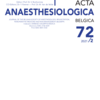A challenge for anaesthesiologists of the future: To reduce our foot- print on this planet
Published online: Mar 28 2022
“Excellence is an art won by training and habituation. We do not act rightly because we have virtue or excellence, but we rather have those because we have acted rightly. We are what we repeatedly do. Excellence, then, is not an act but a habit.” - Aristotle
Climate change represents one of the greatest challenges of our century. Pollution is a major threat to public health and global warming progressively takes us on a one-way path towards extinction of species. Irony of fate, hospitals, where health is central, are often among the main causes of pollution. Often due to lack of initiative, opportunity or wrong minimization, healthcare professionals underestimate the impact of climate changes on public health which will directly cause nearly 250000 deaths per year in 2050 (1).Chung et al. have estimated that in the United States health care activities contributed to 8% of all greenhouse gas (GHG) emissions (2).The practice of Anesthesiology is one of the main sources of hospital’s GHG production, especially by Nitrous oxide (N2O) and halogenated anesthetic vapors such as sevoflurane and desflurane (3).In addition, N2O also contributes to damage the ozone layer. Anesthesia is also responsible for 25% operating room’s waste, being the second major source of hospital’s GHG production. Approximately 60% of anesthesia general waste could be recycled (4).
The physico-chemical characteristics of GHG allows to estimate the global warming potential (GWP): Carbon dioxide has by definition 1 GWP, while N2O, Sevoflurane and Desflurane have 265, 130 and 2540 GWP respectively. At the University Hospital of Liège, the annual consumption of N2O for anesthetic use is about 8103 Kg, which is equivalent to 2147 tons of CO2 , a car ride of approximately 17 million kilometers (Km). As for anesthetic vapors, 640 Kg of sevoflurane and 25 Kg of desflurane are used every year. Together, they contribute to the production of the equivalent of 147.4 tons of CO2 per year or 1.7 million Km by car. If we abolished the use of N2O and desflurane, it would be as if all the employees of our hospital came to work on bicycle for a third of the year.
Carrying out anesthesiology department’s internal audits could help identify some important immediate actions aimed at mitigating this public health disaster such as creating N2O-free operating rooms, abolishing the use of desflurane, generalizing minimum flow anesthesia (<1 L.min -1 fresh gas flow), and preferring total intravenous or loco- regional anesthesia techniques whenever possible. Considering that small adjustments in daily routines can have a massive impact on the ecological footprint, a first important step in this should be evidence-based education of anesthesiologists and trainees on the ecological impact of different aspects of anesthesia management. Reducing anesthesia- related GHG footprint by 50% before 2030 appears easily achievable. We suggest that every anesthesia department includes this objective in its strategic plan.
In conclusion, an ideal anesthetic agent has long been thought as being one with a fast and predictable onset, and both high therapeutic margin and clearance resulting in low toxicity and short duration of action. To these traditional pharmacological properties, it appears more sensible than ever to add the environmental clearance. More generally, the footprint of our practice should be as short-lasting as possible for the well-being of next generations.
